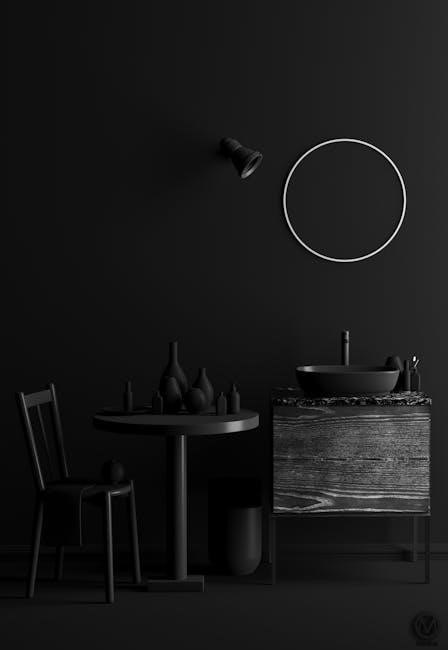Choosing the right table lamp shade size is crucial for both functionality and aesthetics. Proper proportions enhance lighting efficiency and interior decor‚ ensuring a balanced‚ inviting space.
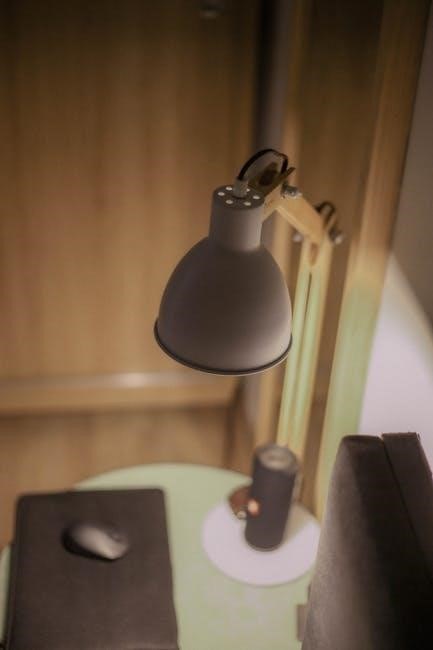
Understanding Lamp Shade Measurements
Lamp shades are measured by top‚ bottom‚ and side dimensions. Round or square shades list one number for each‚ ensuring proper fit and balanced proportions always.
Top x Bottom x Side Dimensions
Lamp shades are measured by their top diameter‚ bottom diameter‚ and side length. For round or square shades‚ one number represents each dimension‚ ensuring proper fit. The top and bottom diameters determine the shade’s width‚ while the side length indicates its height. These measurements are crucial for maintaining balanced proportions. For example‚ a shade listed as 10x14x10 has a smaller top diameter‚ a wider bottom‚ and a side length matching the top. This ensures the shade complements the lamp base without appearing too narrow or overly wide‚ creating a visually pleasing balance.
Round vs. Square Shades
Round and square lamp shades offer distinct aesthetic appeals. Round shades are versatile and suit most spaces‚ creating soft‚ warm ambiance. Square shades‚ however‚ add a modern‚ angular touch‚ ideal for contemporary interiors. The choice depends on the lamp base and room decor. For example‚ a square shade pairs well with a minimalist base‚ while a round shade complements traditional designs. Both shapes are functional‚ but their visual impact varies‚ allowing customization to match personal style and spatial harmony. Consider the overall design theme when selecting between these two popular options for a cohesive look.
Importance of Proper Fit
A properly fitted lamp shade ensures balance and harmony in a room. The shade should be at least 1 cm wider than the base on both sides to maintain proportion. If the shade is too small‚ it may appear top-heavy‚ while an overly large shade can overwhelm the space. Proper fit also affects functionality‚ as it ensures even light distribution. A well-fitted shade enhances the lamp’s stability and aesthetic appeal‚ creating a cohesive look that complements the surrounding decor. Achieving the right fit is essential for both practical and visual satisfaction.
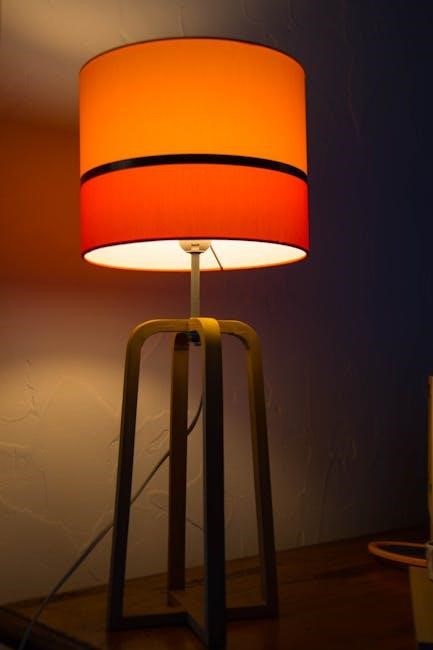
Height and Diameter Ratios
The shade height should be about two-thirds of the lamp base height‚ while the diameter should match or slightly exceed the base height for balanced proportions.
Shade Height vs. Lamp Base Height
The shade height should typically be around two-thirds of the lamp base height for optimal balance. Taller shades can overwhelm the base‚ while shorter ones may look proportionally off. Ensuring the shade height complements the base creates a harmonious design‚ improving both functionality and aesthetic appeal in any room setting. This ratio ensures the lamp remains visually balanced and functional‚ providing adequate lighting without overwhelming the space or appearing too diminutive. Proper proportion enhances the overall decor and usability of the lamp. Always consider the base height when selecting the perfect shade size.
Diameter Guidelines for Different Spaces
Shade diameters vary based on room size and lamp placement. For bedside lamps‚ 10-12 cm is ideal‚ while larger spaces like sitting rooms may require 16-20 cm shades. Pendant lighting often uses similar sizing to match the area they illuminate. Ensuring the shade’s width is proportionate to the room’s scale prevents overwhelming or underwhelming the space. Proper diameter choices enhance both functionality and visual harmony‚ making the lamp a cohesive element in the room’s decor. Always measure the space and consider lamp usage when selecting the appropriate shade size. This ensures optimal lighting and aesthetic balance.
Importance of Proportion and Balance
Proper proportion ensures lamps complement room decor‚ balancing aesthetics and functionality. A well-sized shade harmonizes with the base and surroundings‚ creating a visually pleasing environment.
Matching Shade Width to Base
Matching the shade width to the base ensures a balanced look. The shade should be at least 1cm wider than the base on both sides. For smaller bases (15-20cm)‚ shades of similar width work best‚ while larger bases (20-35cm) require wider shades. A medium shade (around 40cm) pairs well with a base of about 55cm‚ as seen in the Blue Dragonfly Lamp. Properly scaled shades prevent the lamp from appearing too bulky or slender‚ ensuring a harmonious visual balance in any room. This proportion enhances both functionality and aesthetics.
Aesthetics and Room Harmony
Aesthetics and room harmony are greatly influenced by lamp shade size and style. Proportions must align with the space to avoid visual imbalance. For instance‚ smaller shades suit minimalist designs‚ while larger ones complement grand interiors. Material choice‚ such as glass or fabric‚ also impacts the ambiance. Scandinavian designs often feature sleek‚ balanced proportions‚ as seen in the Apollo Table Lamp. Ensure the shade complements the room’s scale and decor. Tall shades are ideal for reading‚ while shorter ones create cozy vibes. Balancing form and function ensures the lamp enhances the room’s aesthetic without overwhelming it. Harmony lies in thoughtful design and proportion.

Choosing the Right Shade Size for Your Room
Match lamp shade size to room proportions for optimal style and functionality. Measure spaces and select shades that complement base heights and room dimensions‚ ensuring harmony and balance.
Bedside Table Lamps
For bedside table lamps‚ choose shades that are 10-12 inches in diameter‚ ensuring they are proportional to the lamp base and table size. The shade height should be roughly two-thirds of the base height‚ creating a balanced look. Opt for smaller shades (around 10-12 inches) for compact spaces or larger ones (up to 14 inches) for taller lamps. Ensure the shade is slightly wider than the base to maintain harmony. The shade should sit at eye level when seated to avoid glare‚ making it ideal for reading. Proper sizing ensures both functionality and aesthetic appeal in the bedroom.
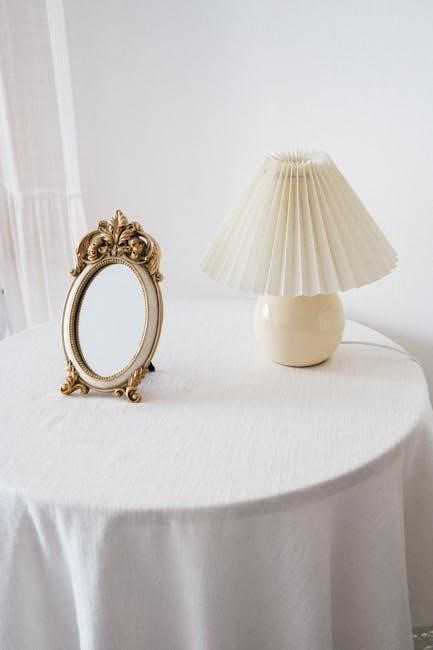
Sitting Room or Large Space Lamps
For sitting rooms or large spaces‚ opt for lamp shades with diameters of 16-20 inches to ensure ample lighting coverage. Shades in this range provide sufficient illumination without overwhelming the space. The shade should be slightly wider than the lamp base to maintain balance. Taller lamps in larger areas can accommodate larger shades‚ but ensure they don’t exceed proportions that might clash with the room’s aesthetics. Proper sizing ensures the lamp complements the space‚ offering both functionality and style for ambient or task lighting needs.
Pendant Lighting Considerations
Pendant lighting requires careful shade size selection to ensure proper illumination and visual balance. For larger spaces‚ shades with diameters of 16-20 inches are ideal‚ while smaller areas may suit 12-14 inches. The shade should be slightly wider than the base to maintain proportion. Consider the height of the pendant; taller spaces can accommodate longer shades‚ but ensure they don’t overwhelm the room. Materials like glass or fabric can enhance the aesthetic‚ but prioritize functionality. Proper sizing ensures pendant lights provide focused task lighting or ambient glow without compromising the room’s harmony.

Material and Style Considerations
Material and style significantly impact a lamp’s aesthetic. Glass shades offer transparency and modernity‚ while fabric shades provide warmth and texture. Scandinavian designs often feature minimalistic shapes‚ blending seamlessly with contemporary interiors. Choose materials that align with your room’s decor for cohesive styling.
Glass vs. Fabric Shades
Glass shades offer a sleek‚ modern look and are ideal for contemporary spaces. They provide excellent light diffusion and are easy to clean. Fabric shades‚ on the other hand‚ add warmth and texture‚ making them perfect for traditional or cozy settings. Glass shades like opal or frosted options create soft‚ even lighting‚ while fabric shades can be tailored to match room decor. Scandinavian designs often feature glass shades‚ such as the tulip-shaped opal glass examples‚ which are both elegant and functional. Fabric shades‚ like gathered styles‚ add a soft‚ organic feel. Choose based on the desired ambiance and style.
Scandinavian Design Examples
Scandinavian designs emphasize minimalism and functionality‚ often featuring sleek‚ organic shapes. The Apollo Table Lamp is a prime example‚ with its soft‚ tulip-formed silhouette in mouth-blown opal glass. Such designs create a warm yet modern ambiance‚ blending seamlessly with contemporary spaces. The lamp’s proportions‚ like a height of 10.5 cm and a bottom diameter of 12 cm‚ showcase the importance of balanced sizing in Scandinavian aesthetics. These designs often prioritize natural light diffusion and timeless appeal‚ ensuring harmony with various interior styles while maintaining a focus on simplicity and elegance.
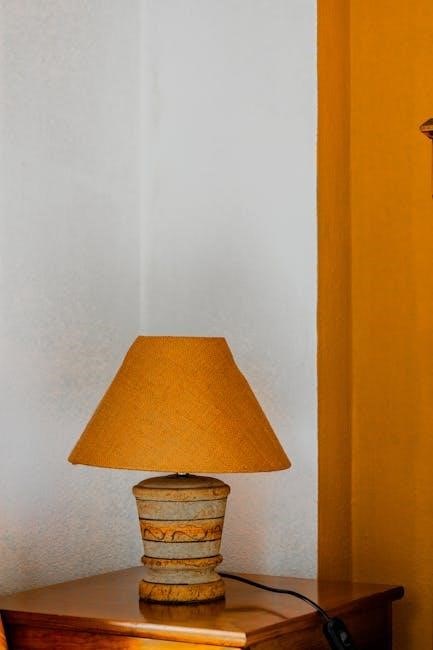
Final Styling Tips
When styling your table lamp‚ ensure the shade complements the base and room decor. For a cohesive look‚ match the shade width to the base and consider the space’s scale. In smaller areas‚ opt for slimmer shades‚ while larger spaces can accommodate wider ones. Materials like glass or fabric add texture and visual interest. Pay attention to the shade’s height‚ ideally two-thirds the base’s height‚ to maintain balance. Lastly‚ test the lighting effect to ensure it provides adequate illumination without overwhelming the space‚ creating a harmonious and functional ambiance.

